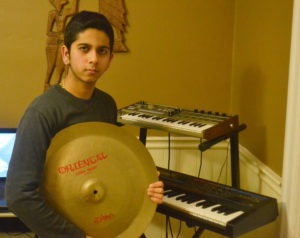 Afraaz Mulji (19) is a passionate musician and curator, also known as Maestro Mi. After learning across Tanzania, India and Canada, he has played at various world renown venues such as the Roy Thompson Hall and Notre Dam. Vijana FM asked Afraaz five questions.
Afraaz Mulji (19) is a passionate musician and curator, also known as Maestro Mi. After learning across Tanzania, India and Canada, he has played at various world renown venues such as the Roy Thompson Hall and Notre Dam. Vijana FM asked Afraaz five questions.
People often say that art is a subject that you can learn outside school. Can you share your sources of learning?
Indeed, art is a subject that can be learned outside of the traditional academic model. In fact, the pursuit of artistic endeavour is not tied to any particular model of learning.
Traditionally, an artist would have a mentor and would learn under their tutelage, however, art is in its essence, a personal experience, perspective and practice.
Therefore, you can learn your craft through practicing your art and from a diversity of sources. These include by studying the great masters of the art, by using the Internet, books and traditionally, through knowledge passed down as oral tradition.
I personally have learned my craft by studying with mentors in music, visual art, and curatorial studies. As well, I have extensively used the internet to study a myriad of artistic concepts and techniques.
I would recommend using everything available in your environment to inspire art. For example, I use the sounds generated by Dar-es-Salaam to inspire my orchestral pieces, both natural and man made.
Art is an intellectual process and an emotional journey, through which we acquire knowledge and perspective. It is a personal journey and each artist will learn differently. Therefore find the best way to learn for you and embrace your creativity and personal search.
Music is an art form that has some best practices, but that is also stretched across genres. How do you recommend learning how to play an instrument – with books, or with instruments?
Learning to play an instrument is a wonderful journey. It can be approached both on a theoretical and practical basis. I recommend that both theory and practice be given equal emphasis.
Historically the way you would learn an instrument, is by learning basic technique from a teacher and then learning how to improvise on your chosen instrument.
From there you would learn the theoretical aspects of your craft, how to compose music: that is write musical notation, learning how to conduct an ensemble etc.
Each world musical tradition has a different set of artistic sensibilities and practices. Indian music is an oral tradition that has been passed down for many generations. Western music has a rich written tradition. Scores from as far back as 2000 years ago have survived and give us a glimpse into early western music.
I have studied many of the world’s musical traditions. I believe that a symbiosis of musical traditions is the way of the musical future. Globalisation has enabled us to live in environments where we are surrounded by all of the world’s diverse musical traditions.
21st century musicians have the privilege of having access to so much of the world’s musical heritage. I recommend approaching music as a pluralistic perspective into our myriad cultures. I advocate musical fusion.
What would you say are good spaces in East Africa where young people can enjoy and engage in creativity and art?
I think dedicated spaces for art and creativity in Tanzania are sorely lacking. There are a few spaces like the Nafasi Art Space, however these spaces are few and far between.
I believe Tanzanian art resides in many informal spaces. There are many artist studios and music studios in Dar if you know where to look. Slipway for example has a large collection of local arts and crafts.
My take on where art and creativity resides: in informal spaces, is a reflection of the lack of official artistic spaces. Tanzania would benefit from building capacity and investing in artistic ventures and venues.
(I personally recommend going to the national museum for a day. They have a good collection of art and culture, including musical performances)
Where will art be in 100 years?
Art is becoming more and more digital. In our digital age, Art is being stored and more importantly, created on computers. In a 100 years, I would venture that digital artistic experiences, including creating virtual art and music through virtual reality platforms will become increasingly common and accessible.
The digitisation of large archives of artistic endeavour will enable people to collaborate, share and create experiences online.
As well, we will have an immense digital architecture of artistic practice to contend with and learn from.
I think of the computer and the internet as instruments of artistic significance and stature.
From your experience, can you share a few careers that would be of consideration to East African students?
Artistic endeavour is indeed a wonderful career to contemplate. To be able to create art and have it financially sustain you is a dream many artists are pursuing.
However, let me be clear, it is not an easy path to take. It is a path riddled with difficulties and struggles.
As a practicing musician, artist and curator, I am still struggling to make ends meet with my art.
So, if you are passionate about your artistic practice and have the courage to make it your career, I commend you for investing in your creativity and artistic endeavour.
Practical tips I would like to impart include; always knowing the value of your art. Do not undersell yourself, do not give your work away for free, it is your intellectual property.
And finally, make sure you build your career around your voice as an artist. Stay authentic to your craft and use your voice to create value and share your ideas with the world.
I salute all the artists, change makers, dreamers and doers out there. What we do is not easy, and is of vital importance to building the culture we reside in.
Thanks Afraaz!
Further reading:

